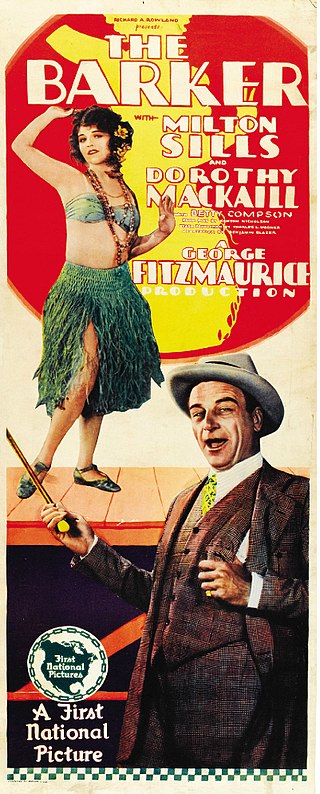
The Barker is a 1928 American part-talkie pre-Code romantic drama film produced and released by First National Pictures, a subsidiary of Warner Bros., acquired in September 1928. The film was directed by George Fitzmaurice and stars Milton Sills, Dorothy Mackaill, Betty Compson, and Douglas Fairbanks Jr. The Barker is a part-talkie with talking sequences and sequences with synchronized musical scoring and sound effects. The film was adapted by Benjamin Glazer, Joseph Jackson and Herman J. Mankiewicz from the play by Kenyon Nicholson.
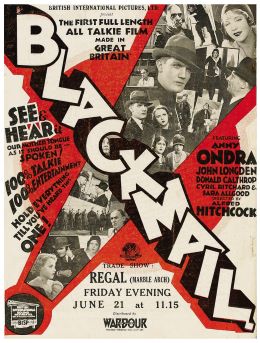
Blackmail is a 1929 British thriller directed by Alfred Hitchcock and starring Anny Ondra, John Longden, and Cyril Ritchard. Based on the 1928 play of the same name by Charles Bennett, the film is about a London woman who is blackmailed after killing a man who tries to rape her.
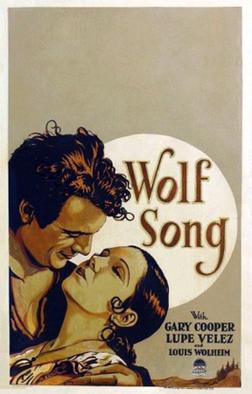
Wolf Song is a 1929 American sound part-talkie Western romance film directed by Victor Fleming and starring Gary Cooper and Lupe Vélez. While the film has a few sequences with dialog, the majority of the film featured a synchronized musical score with sound effects using both the sound-on-disc and sound-on-film process.
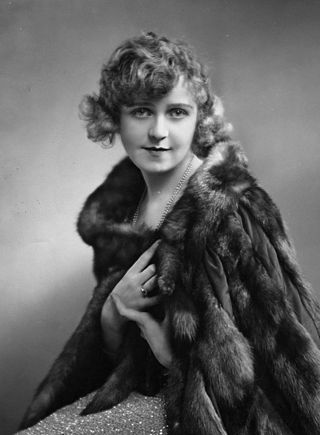
Betty Balfour was an English screen actress, popular during the silent era, and known as the "British Mary Pickford" and "Britain's Queen of Happiness". She was best known to audiences for her Squibs series of films.

Applause is a 1929 American pre-Code backstage musical talkie directed by Rouben Mamoulian and starring Helen Morgan, Jack Cameron, and Joan Peers. It was shot at Paramount's Astoria Studios in Astoria, New York during the early years of sound films. The film is notable as one of the few films of its time to break free from the restrictions of bulky sound technology equipment in order to shoot on location around Manhattan. In 2006, Applause was included in the annual selection of 25 motion pictures added to the National Film Registry of the Library of Congress, being deemed "culturally, historically, or aesthetically significant" and recommended for preservation.

John Stuart, was born to Scottish parents, and was a very popular leading man in British silent films in the 1920s. He successfully made the transition to talking pictures in the 1930s and his film career went on to span almost six decades. He appeared in 172 films, 123 stage plays, and 103 television plays and series.

My Man is a 1928 black and white sound part-talkie American comedy-drama musical film directed by Archie Mayo starring Fanny Brice and featuring Guinn "Big Boy" Williams. In addition to sequences with audible dialogue or talking sequences, the film features a synchronized musical score and sound effects along with English intertitles. The soundtrack was recorded using the Vitaphone sound-on-disc system.

The Single Standard is a 1929 American synchronized sound romantic drama film from Metro-Goldwyn-Mayer directed by veteran John S. Robertson and starring Greta Garbo, Nils Asther and Johnny Mack Brown. The film has no audible dialogue but featured a synchronized musical score and sound effects. The soundtrack was recorded using the Western Electric Sound System sound-on-film process. The soundtrack was also transferred to discs for those theatres that were wired with sound-on-disc sound systems.

The Flying Scotsman is a 1929 British black and white part-talkie film set on the Flying Scotsman train from London to Edinburgh, also featuring the famous locomotive LNER Class A3 4472 Flying Scotsman. In addition to sequences with audible dialogue or talking sequences, the film features a synchronized musical score and sound effects along with English intertitles. Directed by Castleton Knight, the thriller is chiefly remembered for being the first acting role of Ray Milland, as well as for its daring stunts performed aboard the moving train.
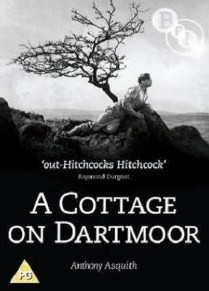
A Cottage on Dartmoor is a 1929 British part-talkie sound film, directed by Anthony Asquith and starring Norah Baring, Uno Henning and Hans Adalbert Schlettow. The cameraman was Stanley Rodwell. In addition to a sequence with audible dialogue or a talking sequence, the film also featured a synchronized musical score with sound effects and English intertitles. The soundtrack was recorded using the Klangfilm Tobis sound recording process. A cut down edited silent version was made for theatres that had not yet converted to sound but this version is no longer extant.
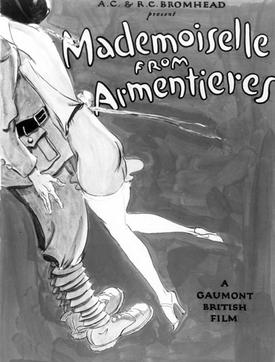
Mademoiselle from Armentieres is a 1926 British World War I silent drama film directed by Maurice Elvey and starring Estelle Brody, John Stuart and Alf Goddard. The film was Elvey's first collaboration with screenwriter Victor Saville. It was followed by a 1928 sequel Mademoiselle Parley Voo.

Estelle Brody was an American actress who became one of the biggest female stars of British silent film in the latter half of the 1920s. Her career was then derailed by a series of ill-advised decisions and she disappeared from sight for many years before re-emerging between the late 1940s and the 1960s in smaller supporting film and television roles.

Hindle Wakes is a 1927 British silent film drama, directed by Maurice Elvey and starring Estelle Brody and John Stuart. The film is adapted from Stanley Houghton's 1912 stage play of the same name, and reunites Brody and Stuart following their hugely popular pairing in the previous year's Mademoiselle from Armentieres. The film was also released under the title Fanny Hawthorne.

Under the Greenwood Tree is a 1929 British sound part-talkie historical drama film directed by Harry Lachman and starring Marguerite Allan, Nigel Barrie and Wilfred Shine. It is an adaptation of the 1872 novel Under the Greenwood Tree by Thomas Hardy.

The Crimson Circle is a 1929 British-German sound part-talkie crime film directed by Frederic Zelnik and starring Lya Mara, Fred Louis Lerch, and Stewart Rome. In addition to sequences with audible dialogue or talking sequences, the film features a synchronized musical score and sound effects along with English intertitles. The sound was recorded via the De Forest Phonofilm sound-on-film process. The film is an adaptation of the 1922 Edgar Wallace novel The Crimson Circle in which Scotland Yard detectives battle a gang of blackmailers. A previous UK version was filmed in 1922.
The Plaything is a 1929 British part-talkie sound romance film directed by Castleton Knight and starring Estelle Brody, Heather Thatcher and Nigel Barrie. The film was a mixture of silent and sound film as it was released during the transition period following Blackmail. It was based on the play Life Is Pretty Much the Same by Arthur Jarvis Black. It was made by British International Pictures at Elstree Studios.
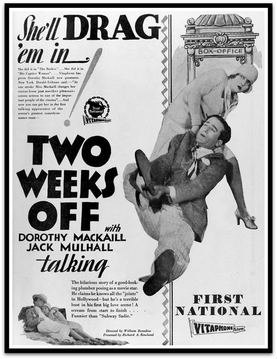
Two Weeks Off is a 1929 American sound part-talkie comedy film directed by William Beaudine. In addition to sequences with audible dialogue or talking sequences, the film features a synchronized musical score and sound effects along with English intertitles. The soundtrack was recorded using the Vitaphone sound-on-disc system. A complete nitrate print survives at UCLA.
The Charlatan is a 1929 sound part-talkie film directed by George Melford for Universal Pictures. In addition to sequences with audible dialogue or talking sequences, the film features a synchronized musical score and sound effects along with English intertitles. The soundtrack was recorded using the Western Electric sound-on-film system. The film starred Holmes E. Herbert, Margaret Livingston and Rockliffe Fellowes. The film is based on the 1923 play The Charlatan by Leonard Praskins and Ernest Pascal.

The Sap is a 1929 American sound part-talkie comedy film directed by Archie Mayo and written by De Leon Anthony and Robert Lord. In addition to sequences with audible dialogue or talking sequences, the film features a synchronized musical score and sound effects along with English intertitles. The soundtrack was recorded using the Vitaphone sound-on-disc system. The film is based on the 1924 play The Sap by William A. Grew. The film stars Edward Everett Horton, Alan Hale Sr., Patsy Ruth Miller, Russell Simpson, Jerry Mandy and Edna Murphy. The film was released by Warner Bros. on November 9, 1929. This film was the last "part-talkie" produced by the studio.

Modern Love is a 1929 American sound part-talkie comedy film directed by Arch Heath and written by Albert DeMond and Beatrice Van. In addition to sequences with audible dialogue or talking sequences, the film features a synchronized musical score and sound effects along with English intertitles. The soundtrack was recorded using the Western Electric sound-on-film system. The film stars Charley Chase, Kathryn Crawford, Jean Hersholt, Edward Martindel, Anita Garvin and Betty Montgomery. The film was released on July 21, 1929, by Universal Pictures.


















